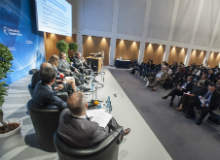
The transport sector is at a difficult crossroads. Intense pressures are mounting in the run-up to this year’s Paris Climate Conference (COP15) to implement quick, efficient and cost-effective solutions for sustainability.
The climate change mitigation drive comes in the context of a fourfold increase in global freight volumes by 2050, while the market is forced to adjust to new transport routes emerging between developing economies.
“The global thermostat continues to rise,” warned UN Secretary-General Ban Ki-moon in his opening address at the International Transport Forum (ITF) on 27 May, as he urged transport leaders to accelerate their efforts to tackle climate change.
“Climate impacts are increasing. Your actions can help the world travel more quickly down a low carbon pathway,” Ki-moon said.
Find new green solutions, be a champion within your industry and urge others to commit to a new sustainable transport future. You help connect the world. With your help, we can make a world of difference.”
At the moment, freight transport in international trade is responsible for around 30% of the world’s CO2 emissions, an ITF report highlighted. As a result, eyes are turning towards the railway sector as a relatively clean method of freight transport capacity-building, considering rail only accounts for 1% of these emissions.
But that is not good enough, declared International Union of Railways (UIC) director general Jean-Pierre Loubinoux in an interview during the forum: “We want to do better. We really want to achieve pragmatic steps towards the 2°C scenario, which is becoming a critical world issue.”
Making tangible changes is the crucial factor in winning back the public’s trust regarding climate change, according to Smart Freight Centre executive director Sophie Punte. The “concrete actions” Punte proposed included scaling up an alternative fuel like liquefied natural gas, increasing load factors of trucks in China or implementing worldwide efficiency standards.
Such steps would have to be taken sooner rather than later, as the global rise in freight quantities is bound to intensify CO2 emissions.
Re-drawing the map of international trade
But this increase is just another pressure as part of a wider shift of influence predicted by 2050. The same ITF report foresees that “the transportation corridor between the US and Asia will be subject to the highest flow of goods in both directions”, while “the North Pacific corridor will surpass the North Atlantic as the main freight corridor”.
The creation of cross-continental transport routes was the other central point of discussion at the forum. As China is scaling up plans for its Silk Road revitalisation, a panel of leading transport and logistics figures from Morocco, South Korea and Europe debated the challenges of changing transport patterns and the need to adapt to them.
To symbolise the trend of new, growing markets, Morocco’s Deputy Minister of Transport Mohamed Najib Boulif expressed his country’s ambition “to become an emerging country by 2025”. After investing €16bn on transport infrastructure over the past five years, a further €3bn spending in public-private partnership (PPP) agreements is planned for 2015.
“There will be a shift to the locations of markets,” Loubinoux said. “The most significant trend in the 21st century is an intelligent complementarity between modes.” He stressed the importance of adjusting infrastructure to accommodate the growing trade between Europe and Asia.
Loubinoux admitted that compared to roads, rail lacks a certain degree of flexibility for the customer, but what UIC is looking for is interoperability: “Rail has a number of added values such as capacity, safety and sustainability, which is more and more at the forefront of decisions nowadays.”
Vinge station will sit in the heart of the city and serve as a link not only to other towns, but also to its own natural and urban spaces.
“Rail can be the backbone of transportation, mixed with long distances and proper logistics to articulate distribution,” he concluded.
But to achieve this common goal of rail-based intermodal transport systems, the speakers agreed that the challenge lies in policy and administration. What Korea Transport Institute (KOTI) vice president Jaehak Oh referred to as “non-physical barriers” are the laws, customs procedures, regulations and border policies which prevent the smooth operation of cross-continental freight transportation.
Loubinoux admitted that “rail has a long way to go before it achieves administrative interoperability”.
“We have to merge different old standards. Whatever we do new should respond to international changes. This is the work of UIC, to transform our leaflets into the rail standards which could become non-voluntary but recommended standards for a long time to come.”
Speakers agreed that in the context of a changing and developing world, the transport sector needs not only to meet demand and operate profitably, but also become aware of its wider impact on society: “There will be a change on the matter of transport,” Boulif said.
“Societies change and transport develops. Given those changes, there is a very important question: do we have to bear with those developments, or should we encompass and steer those developments so that they are of benefit to society?”



